
The 8mm Mauser was a highly influential modern cartridge that is well designed and straightforward to handload.

Powders that perform well in the 30-06 such as Accurate 4350, IMR-4350 and Hodgdon H-4350 are also excellent choices for the 8mm Mauser.
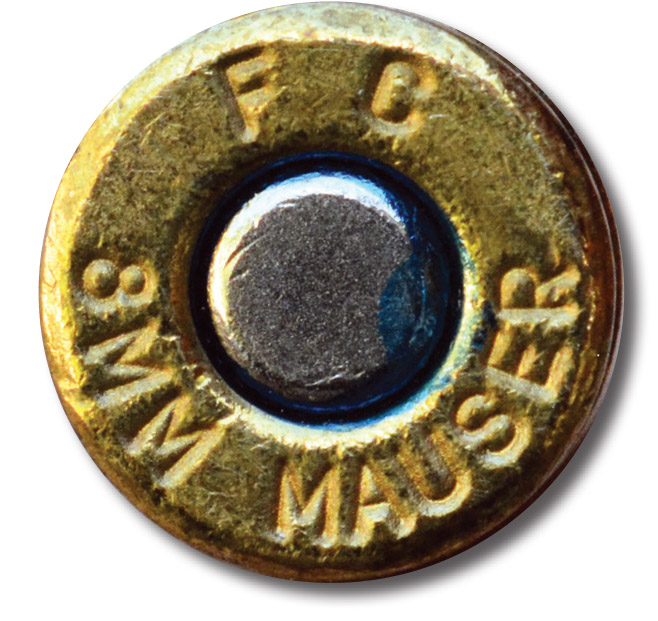
In the U.S., SAAMI identifies the 8x57JS as “8mm Mauser” or “8x57mm.”
The 8mm Mauser or 8x57mm, both of which are Sporting Arms and Ammunition Manufacturers’ Institute (SAAMI) designations, is one of the most important and influential cartridges in the history of small arms. In Europe, the Commission Internationale Permanente (C.I.P.), the European equivalent of SAAMI, references it as the 7.92x57mm Mauser and 8x57IS. Apparently, the U.S. nomenclature is also known worldwide. For example, while hunting throughout Europe, I was handed a borrowed rifle to pursue stag, European boar and other species. In his broken English, my gracious host referred to the finely crafted pre-World War II rifle as being an “8mm Mauser!” It boasts of being one of the most widely used military cartridges worldwide. For example, I doubt that anyone really knows how many Mauser 98 rifles have been manufactured by many countries, but most sources agree that it easily exceeds 100 million! The majority of those rifles were chambered in 8mm Mauser. That simple fact makes it hugely popular worldwide.

The 8mm Mauser (left) shares the same case head dimensions as the 30-06 Springfield (right).
Soon after the 8mm was developed in 1888, and still not generally available in the U.S., American shooters were introduced to .30-caliber rifles such as the 30-40 Krag (1892), 30-30 Winchester (1895), 30-03 and 30-06 Springfield (1903 and 1906 respectively). Today, the list of great .30-caliber cartridges that are popular in the U.S. is especially long. The .30-caliber quickly became the most favored caliber for U.S. hunters and shooters and the 8mm just never really gained widespread acceptance. This was in part due to the lack of availability of guns and ammunition, but also the stigma related to its metric designation. Today, it seems most of the 8mm’s popularity is connected to small arms military collectors, but many enjoy shooting these historic rifles. Nonetheless, just like the 30-06, it is a great hunting cartridge when used with proper bullets and loads.

Understanding the history of the 8mm Mauser and the rifles that have been chambered is very important prior to shooting a gun (with any ammunition) or developing handloading data. As indicated, the 8x57J was originally developed in 1888, but rifles featured a groove diameter of around .318 inch (some sources suggest that groove diameter was accepted as large as .320 inch), while bullets measured around .318 inch. To add to this confusion, the “J” was a mistranslation for “I.” In Europe and most other parts of the metric world, ammunition with just the J (or I) indicates that bullets are .318 inch. Generally speaking, all rifles produced from 1888 through 1904 to 1905, including the German Commission Model 1888, and variations of the remarkable Mauser 98, featured the previously mentioned .318-inch groove diameter. Many commercial rifles retained the smaller caliber barrels until after World War I, while some small European rifle builders used them until the start of World War II.

All 8mm Mauser military rifles produced since 1905 feature a .323-inch groove diameter and modern bullets correspond with that barrel size.
In 1905, the cartridge received a new designation of 8x57JS, 7.92x57mm Mauser and 8x57IS. If ammunition is labeled with a “JS” (or “IS”) then it contains bullets of .323-inch diameter. Never, ever, use ammunition or bullets measuring .323 inch in rifles with the .318- to .320-inch groove diameter or high pressures will occur. (Note: The “S” bore indicated .323-inch groove and stood for originating “Spitzgeschoss.”)

Industry maximum overall cartridge length for the 8mm Mauser is 3.250 inches. However, most factory loads are notably shorter.
The 8x57J was originally loaded with a 227-grain roundnose profile bullet and propelled with smokeless powders to 2,067 feet per second (fps). By definition, it was a cutting-edge modern cartridge. But in 1905, along with the previously mentioned groove diameter and name change to 8x57JS, the bullet was changed to 154 grains and boasted of 2,891 fps velocity. This was very impressive for 1905, but it was further modernized with a sleek spitzer profile bullet that offered a huge advantage for long-range work over virtually all other period cartridges that were loaded with heavyweight roundnose bullets – including the period U.S. military cartridge, the 30-03 Springfield. The advantages of the new 8mm for long-range work and military applications were leaps and bounds ahead of period competing cartridges. World military leaders took note of this hugely important and influential cartridge and began making changes to their own cartridges and loads to compete. For instance, U.S. brass quickly replaced the 220-grain roundnose bullet contained in the 30-03 Springfield with a similar 150-grain spitzer bullet, increased the muzzle velocity to around 2,700 fps, shortened the case slightly and the 30-06 Springfield arrived that allowed U.S. to fully modernize its service cartridge.

The suggested trim-to case length for the 8mm Mauser is 2.240 inches, while maximum length is 2.247 inches.
While there has been much discussion about the 8mm’s two basic groove diameters, a couple of measurements that are rarely mentioned include the actual bore diameter that remained more or less the same at .311 to .3125 inch. This resulted in deeper grooves and more pronounced rifling in the larger caliber barrel. I can only speculate on the reasoning behind this specification, but the deeper grooves might have resulted in a longer barrel life, which in a military rifle could prove important. Along with this change was a rather long tapered throat that measured around 13⁄8 inches. Incidentally, the barrel twist rate is 1:9.45 inches, or slightly faster than 1:9.5 inches, which readily stabilizes bullets weighing from 150 through 227 grains.
The 8mm case is strong and still as modern as ever. It is rimless with an undercut extractor groove within the head. The shoulder is 20-degrees 48 minutes, the case length is 2.247 inches and the overall cartridge length is 3.250 inches. But what is almost never mentioned is that the 8x57 shares exactly the same case head dimensions as the 30-03 and 30-06 Springfield. Clearly, U.S. designers started with the 8mm case to design the 30-03 and 30-06 cartridges, but lengthened it to 2.494 inches, necked to accept .308-inch bullets, changed the shoulder angle slightly to 17 degrees 30 minutes, made a longer neck and increased the overall cartridge length to 3.340 inches. With that thought in mind, consider how many cartridges are based off of the 30-06 case or case head that includes many short- and long-action cartridges such as the 270 Winchester, 308 Winchester and a host of others from Savage, Remington, Federal, etc. Without the 8mm Mauser, I can only wonder what our lineup of modern cartridges might look like.

Domestic commercial bullet manufacturers offer a variety of 8mm bullets.
It seems that Europeans are savvy about cartridge nomenclature and there is little concern about someone foolishly loading modern, high-pressure “JS” cartridges into older rifles with tight bores. As a result, the C.I.P. lists a maximum average pressure for the 8x57JS at 56,560 psi. But SAAMI lists maximum average pressure at just 35,000 psi (or 37,000 CUP). As a result, this fine cartridge has traditionally given dismal performance from U.S. ammunition manufacturers. For example, Federal Cartridge lists a 170-grain roundnose bullet at just 2,250 fps, Remington and Winchester each list a 170-grain expanding roundnose bullet at 2,360 fps, which is less powerful than the old 300 Savage. Sources suggest that SAAMI has concerns that 8x57JS loads will end up in rifles with the tighter barrels, which explains their conservative approach. However, new factory loads are offering significant improvement. For example, Hornady offers a 195-grain softpoint and a 196-grain BTHP, each at 2,500 fps and Nosler offers a 180-grain E-Tip at 2,550 fps. While these latter loads are not loaded to C.I.P. pressures, performance is still respectable.

Brian used a German Mauser K98k chambered in 8mm Mauser to develop “Pet Loads” data.
In developing the accompanying data, I chose to more or less duplicate the pressures as loaded by Hornady and Nosler and most loads are similar to suggested C.I.P. loads and pressures. Incidentally, many modern reloading manuals are offering data that is very similar to C.I.P. guidelines. The accompanying data is intended to be used only in rifles with the larger groove diameter and that are in good working condition with proper headspace. If in doubt, have your gun examined by a qualified professional. It should be noted that many Mauser K98k rifles are marked just forward of the stamped plant number in regard to barrel groove diameter with a metric designation such as 7.91. With that said, with so many guns being reworked or rebarreled during their lifetime, I highly suggest you slug the barrel of your rifle to determine exact bore dimensions prior to shooting with modern loads utilizing .323-inch bullets. It is especially important to begin with suggested starting loads and then work up carefully to maximum loads while watching for signs of excess pressure.

The Mauser 98 action is truly legendary due to its ultra reliable and rugged design.
In measuring the water capacity of cases produced by several manufacturers, including Federal, Hornady, Nosler, Prvi Partizan, Remington and Winchester, their capacity variance is between 1 to 3 grains (and for the curious, was on average about 5 grains less than the 30-06 Springfield). This is another reason to avoid starting with the maximum listed load data, as cases with less capacity will usually produce higher pressures. NoslerCustom cases were selected to develop “Pet Loads” data. They are fully prepared and ready to load. For example, they are weight sorted, full-length sized, trimmed, chamfered and flash holes deburred. In preparing the data, after the initial 400 new NoslerCustom cases had all been fired, they were then full-length sized using Hornady dies and loaded again and again for the next shooting session. All cases were primed using Winchester Large Rifle (standard) primers.
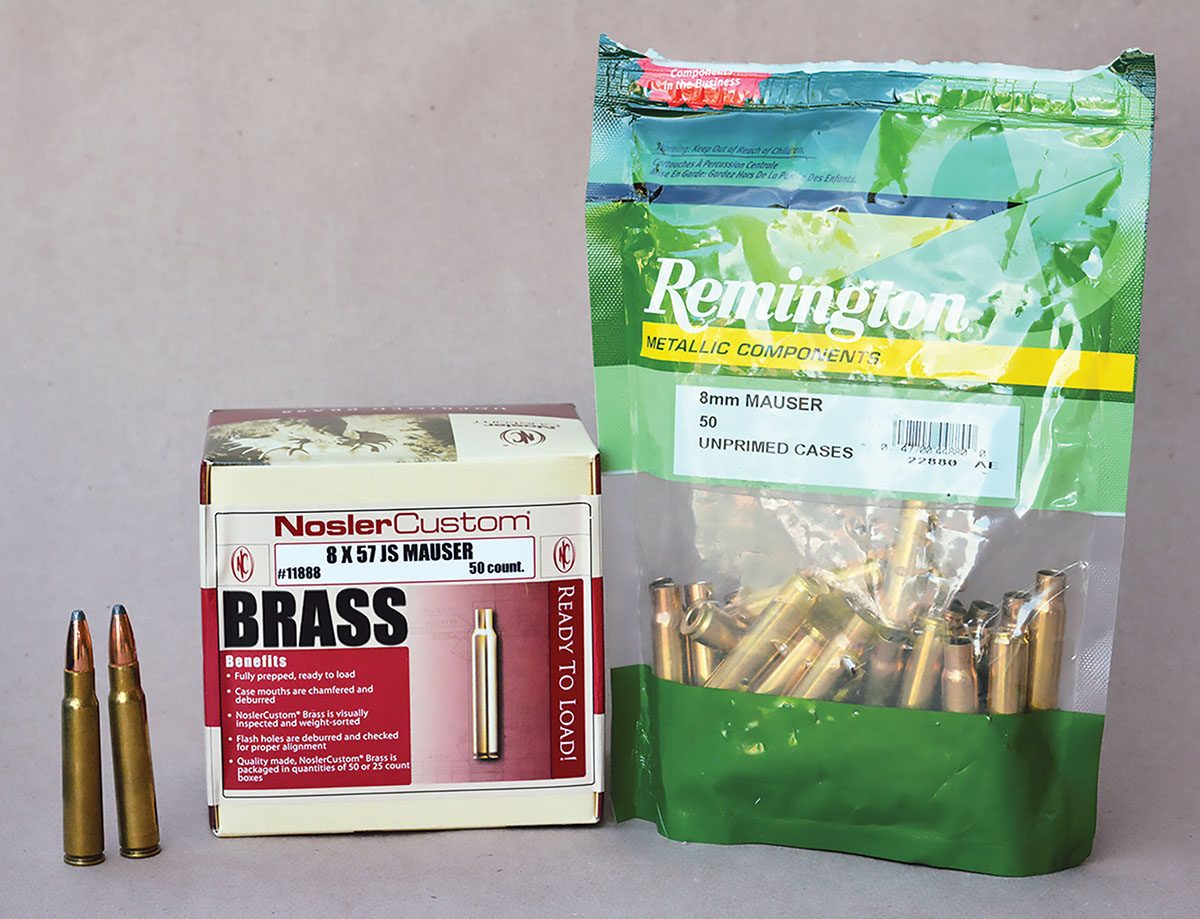
Mauser 8mm cases are readily available to handloaders. Brian used Nosler Custom cases to develop “Pet Loads” data.
The test rifle was a German Mauser K98k with a 23.62-inch barrel and featured (of course) a .323-inch groove diameter. In spite of this being a service rifle, it is good mechanically and the bore is in good condition with only modest wear.
The 8mm Remington Magnum was introduced in 1978, while the 325 Winchester Short Magnum was offered in 2004. With those two 8mm cartridges intended primarily as modern magnum hunting rounds, new .323-inch bullets have been offered that also serve to improve the 8x57 Mauser for hunting and even long-range target work. A couple of examples include the Nosler 180-grain Ballistic Tip, the Hornady 195-grain Soft Point, the Speer 200-grain Hot-Cor and the Nosler 200-grain Partition. With these bullets, the 8x57 Mauser is capable of taking all game in North America and thin-skinned African plains game. For those seeking more traditional bullet weights reaching between 2,800 and 2,900 fps, 150-grain expanding softpoint bullets from Hornady, Sierra and Speer performed well and are excellent choices for hunting deer-sized game.
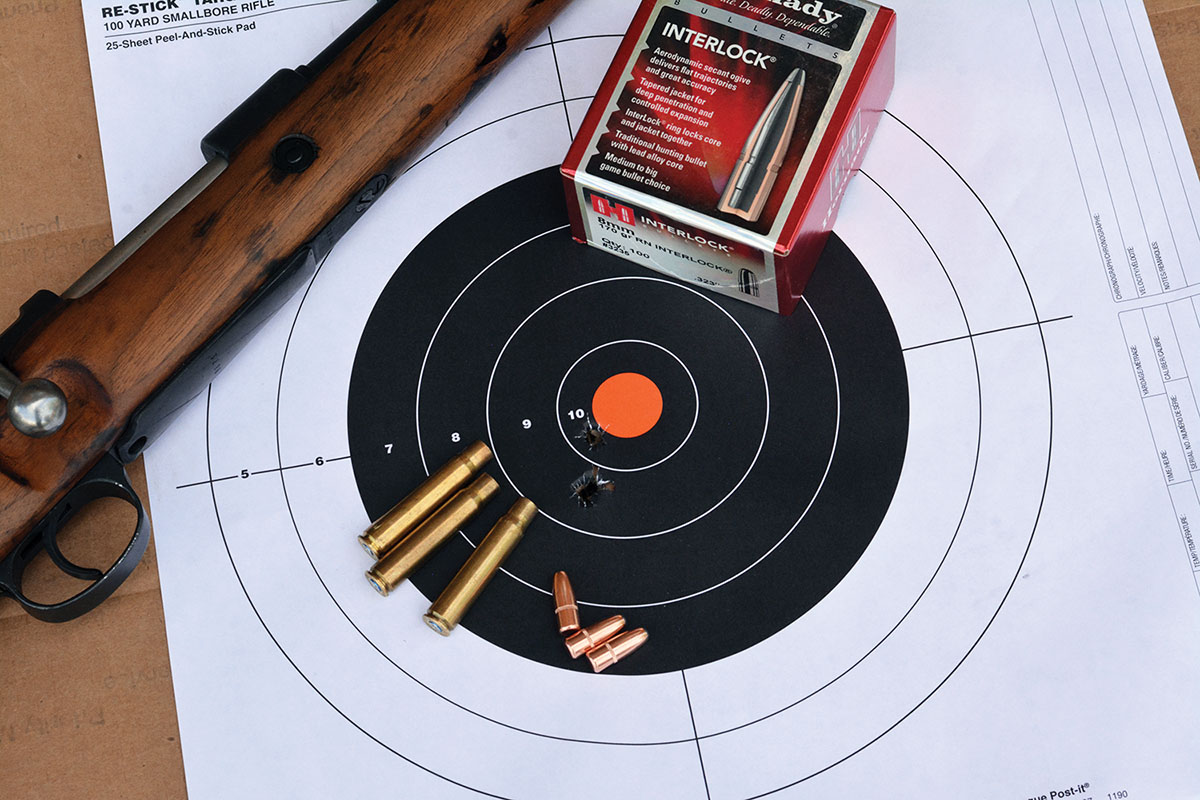
With proper load development, the 8mm Mauser can produce good accuracy, such as this 75-yard group fired with iron sights.
The same powders that perform best (in terms of velocity and accuracy) in the 30-06 will generally give the best results in the 8x57 Mauser. A few standout choices include IMR-4064, IMR-4895, IMR-4350, Accurate A-4350, A-2520, Ramshot Big Game, Hodgdon H-4350, H-4895, Varget, H-380, Alliant Reloder 15 and Vihtavuori N150. As a general rule, spherical powders should not be reduced further than their suggested starting charges.
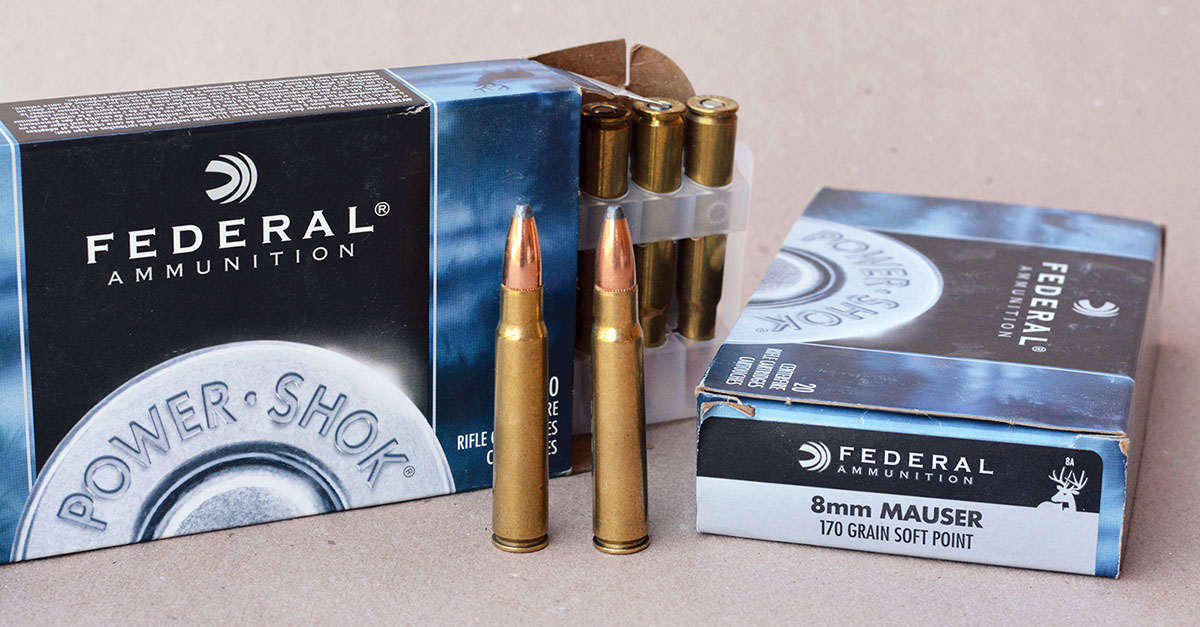
U.S. ammunition manufacturers have historically loaded the 8mm Mauser to 35,000 psi due to concerns that ammunition will be fired in early rifles with .318-inch groove diameters, which limited performance.
One thing that is noteworthy includes velocity variations using the same load, factory or handloaded, but fired from two different rifles (or test barrels). In some instances, it was around 100 fps, but in other instances it exceeded 200 fps. But what is really odd is that it was not consistently the same. In other words, one load would produce similar velocities in both the test barrel and the Mauser rifle, but a different load would produce a much larger discrepancy. I noticed this when working with data published by labs, which prompted phone calls to ballisticians. It seems that I am not the only one who has observed this oddity and I do not have hard and fast answers. However, one consistent factor is that as barrels wear, velocity tends to decrease and continues to drop off as the wear continues, which is more or less normal with all rifle cartridges. With the 8x57 Mauser’s comparatively deep-cut rifling, rifles seem to continue shooting reasonably well in spite of wear. Most labs keep fairly fresh pressure barrels on hand, so they usually give higher velocities than a surplus military rifle. But further tests would need to be conducted to establish the effect on velocity of the 8x57’s deep-cut rifling, barrel wear, etc. when compared with more modern pressure barrels.
The 8mm was adopted by many countries, racked up an impressive service record and proved its value as a very capable sniper cartridge. It served through many wars and skirmishes, including both World Wars and remains in service by hunters and shooters. Like it or not, it was groundbreaking and influential with design features that many of our modern cartridges benefit from.
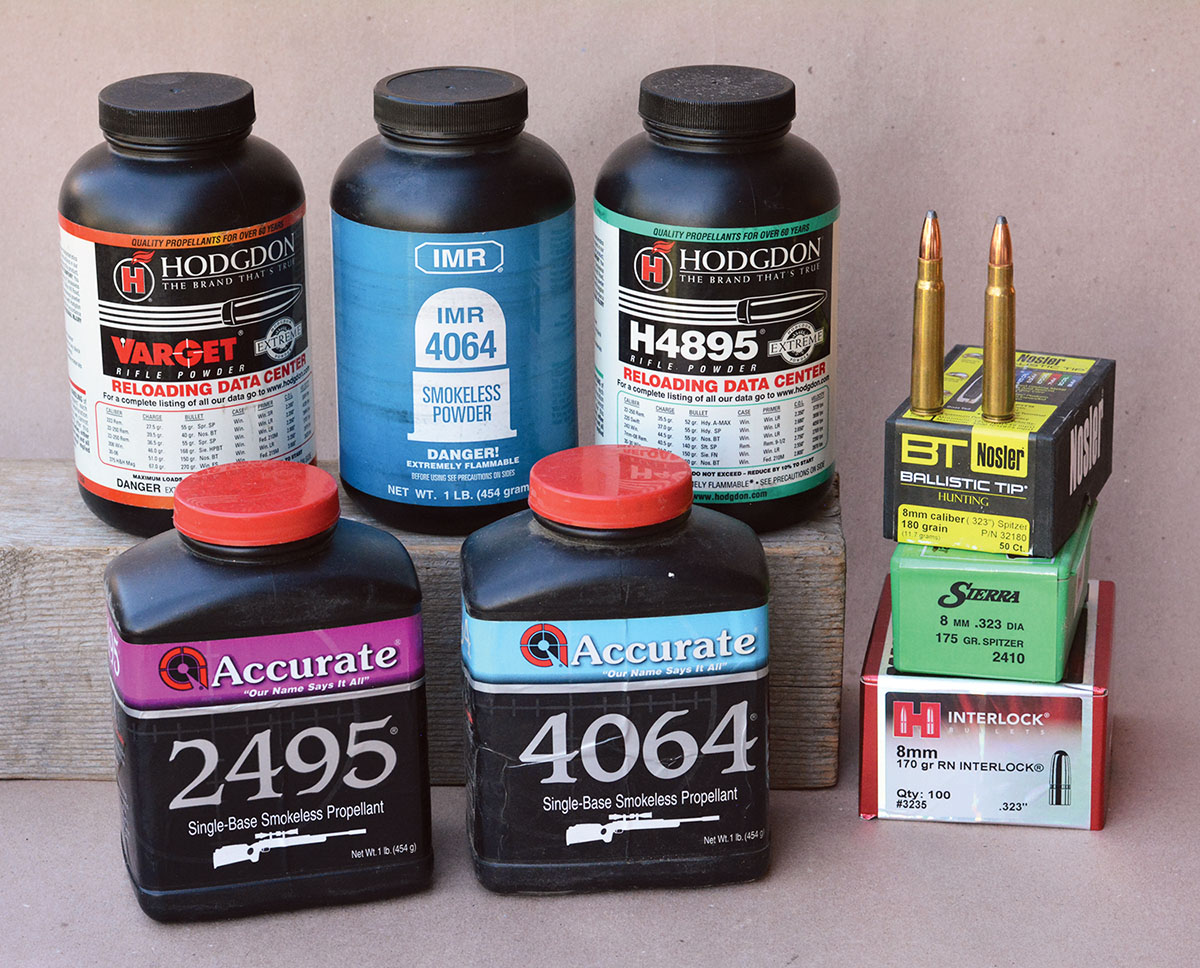
Medium burn rate extruded powders gave excellent results with 170- to 180-grain bullets.















.jpg)
.jpg)


